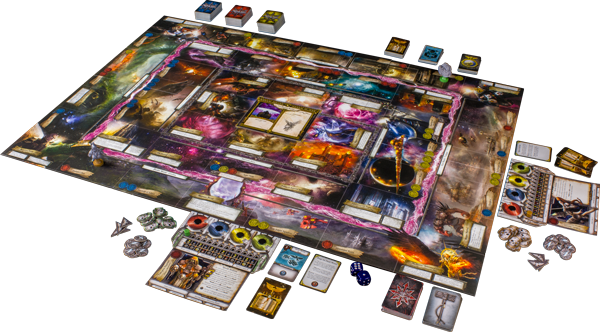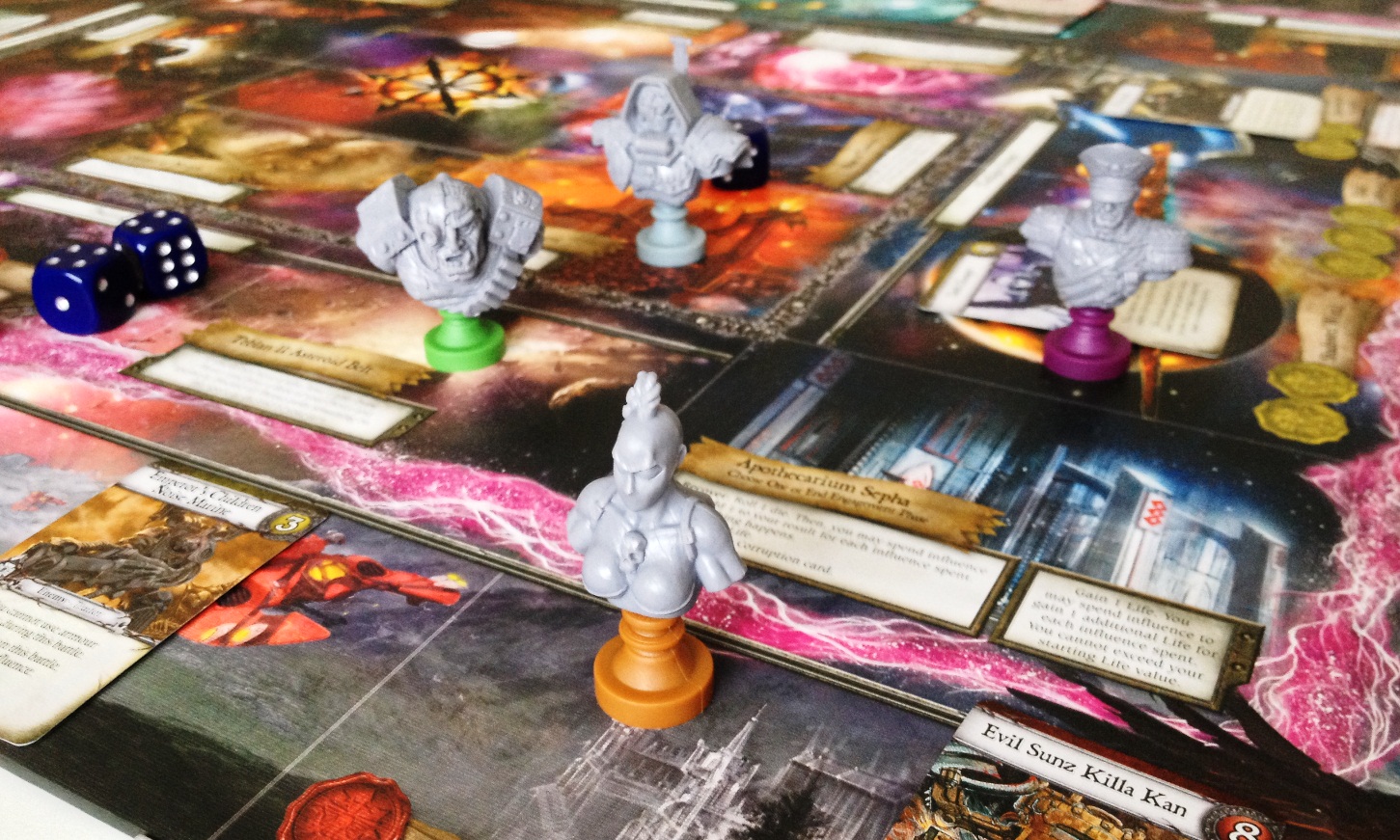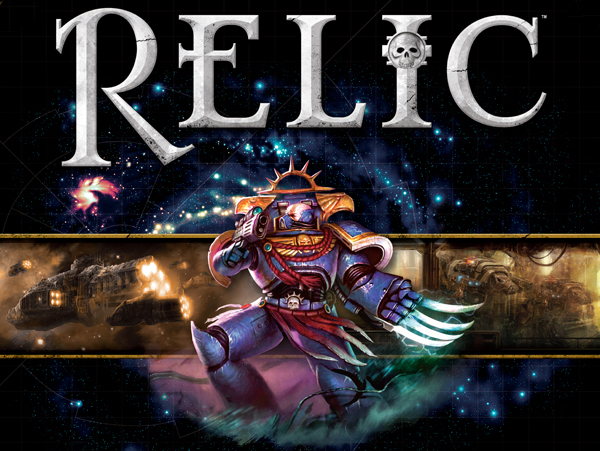For those not familiar with the setting, the 41st millennium is home to Games Workshop’s sci-fi wargame. It’s a dark and grim future where humanity is in decline, being attacked on all sides by brutal Orks, crafty Eldar and vile bio-engineered Tyranids. The fourth enemy is from within. The Warp, humanity’s means of interstellar travel has released the daemons of chaos who wish to corrupt and transform humanity into something quite nasty.
 |
| Lots of cards, lots of tokens, yes it's a Fantasy Flight Game. |
In Relic, you take on the role of one of the heroes of the Imperium as you explore the Antian sector and attempt to defeat the chaos presence at the centre of the warp rift. The type of threat posed is based on one of five scenarios. Each one affects the game in subtle ways and may have you defeating a greater daemon of Tzeentch or attempting to destroy a Chaos Manufactorum (factory to you and me). After selecting your hero you get handed their very nifty player card and dial system. This not only keeps track of all your stats but also outlines how your character will advance. Considering it’s just a piece of card and some dials it works very well and feels like a true innovation in board gaming.
 |
| Levelling up is controlled by the nifty player card. |
You’ll then be handed your first mission. To enter the warp rift at the centre of the board you’re going to need a Relic, a prized piece of humanity’s technology and a very powerful item for you to use. To gain access to a Relic you have to prove you are worthy of it by completing three missions. These missions involve seemingly simple tasks such as visiting a particular location or landing on the space of another player. These missions drive the game forward and give purpose to your adventures.
 |
| The character busts are rather nice. |
Play is pretty straightforward, roll a dice and move that many spaces around the board in a direction you wish and then draw threat cards as indicated by the space you land on. The threat cards are colour coded to represent the three alien races you’ll face and largely represent the type of skill you’re going to need to defeat them. I say largely, every so often a random encounter will test a different kind of skill which catches you off guard. Most encounters are combat based and consist of rolling a dice, adding your skill and then getting another player to do the same for your enemy. There’s a bit more to it than that though, roll a 6 and the dice ‘explodes’ and you get to roll another dice, roll a second six and then another and so on. Exploding dice mean that players always have a chance of defeating the most powerful adversaries; unfortunately your foes can do the same. The second little aid in combat is the power cards. Power cards have two sections to them, ability and a number, at any time a player can replace a potential dice roll with a power card, using its number in place of the die result or players can use the ability as described on the card. This makes power cards a particularly prized item and having a character who can easily replenish their spent power cards is particularly strong. As the game progresses players level up, upgrade their skills, grab war gear and hopefully complete the missions required to acquire a Relic.
 |
| Not all the threat cards are bad, some actually help, though not many. |
Relic is a great blend of theme and mechanics, the rules aren’t too complex and the sense of adventure runs throughout. It isn’t a particularly tactical or strategic game. You’ll have a general aim in mind, such as complete a particular mission or upgrade your character’s equipment, but generally things happen to your character and your goal is to ride these out or take advantage of them. This randomness is what Relic is all about and shouldn’t necessarily be taken as a bad thing. Those insightful amongst you may have noticed the main fault in Relic; roll and move. Yes, its 2013 and it’s Relic’s biggest flaw. The game does attempt to overcome this by allowing you to use Power cards to tweak your dice rolls. The problem is these power cards are in short supply. Not having a power card handy and wanting to land on an exact space to complete a mission or move onto the next region can be infuriating and can really hinder a player’s progress.
 |
| The game gets harder the nearer you get to the centre. |
Relic is awash with the Warhammer 40,000 theme, players familiar with the setting will recognise characters, places and weapons but you don’t need to be a Warhammer nut to appreciate the game. Relic’s mechanics and artwork means that players can grasp the game as a generic space opera and not have to differentiate their Ghazghkulls from their Fabius Biles. This theme is strongest in the form of the corruption system. The lure of chaos is ever present and players are tempted at every turn by corruption cards. These are often offered in exchange for level or skill advances or can be picked up along with an encounter. Each corruption card has a threshold level; the effect of the card doesn’t kick in unless the number of corruption cards you own is above that corruption level. The cards are a mixture of positive and negative effects and you’re never sure whether the chaos gods will bless you and aid your quest or mock you with a crippling weakness. Be careful though, too many cards and your character succumbs completely to chaos and is taken out of the game, you can then take a new character but since full corruption is more likely towards the end of the game you’re going to be hard pressed to catch up with the other players.
 |
| Corruption cards offer vile gifts or heretical curses but don't activate until you are suitably corrupted. |
I've resisted so far but it is hard to talk about Relic without comparing it to Talisman. Talisman’s hereditary is clear in many aspects of the game; the roll and move, the board layout and the centre threat. Several tweaks have been made that address many of the issues that exist with the original game. The level and skill cap mean there’s no need for players to continue levelling forever; there comes a point where not attempting to compete the scenario is just time wasting. The power cards in particular help level out a some of the randomness of dice rolls and are my favourite addition to the game. The biggest change though, and the one that makes the game much more palatable to those who believe there is a lack of choice in Talisman, is the themed threat decks. Now there are more meaningful decisions on where to move and players can attempt encounters where they are more powerful but there is always the risk that the threat deck will throw something unexpected at you. All these changes make Relic a tighter, smoother and more consistent game than Talisman but still maintain the randomness to keep you on your toes. The game also tends to play quicker than Talisman but it can still drag on for over three hours, especially on the more difficult scenarios. Even with all these additions the game can still fall victim to the randomness; your dice may fail you or the threat deck may produce something really nasty. The biggest of these issues is the return of the roll and move; there is nothing more frustrating than having to complete a mission by landing on a particular space and not getting the dice roll you need to do so. One aspect of Talisman that is missed though is the direct combat. Talisman is just as much about attempting to screw over the opposition as it is about winning and, although there are opportunities to screw your opponent, in Relic they are few and far between.
 |
| The board is a gaudy and sometimes difficult to read but the artwork is stunning. |
 The question on whether this game is for you will depend on your previous experience with the Warhammer 40,000 universe and Talisman. If you’re a fan of both then this is a must buy; it gleefully combines the Talisman mechanics with the scale and themes of the dark millennium setting. Talisman fans should definitely pick this up; you’ll appreciate the improvements but may miss the lack of direct confrontation. If you’re not a fan of Talisman, then the changes that Fantasy Flight Games have implemented, although great, may not be enough to persuade you to switch. Randomness and luck are still at the heart of the game and if you don’t like these in your game then Relic won’t be for you. Last but not least are the Warhammer 40,000 fans that might be new to the world of board games who will love all the 40k references. Relic is a smoother tighter game and more timely game than its parentage with the power cards and corruption system are both great mechanics that build on the basic framework of Talisman and make it into something greater. This game is exactly what it should be; an entertaining adventure filled caper through the Warhammer 40,000 universe.
The question on whether this game is for you will depend on your previous experience with the Warhammer 40,000 universe and Talisman. If you’re a fan of both then this is a must buy; it gleefully combines the Talisman mechanics with the scale and themes of the dark millennium setting. Talisman fans should definitely pick this up; you’ll appreciate the improvements but may miss the lack of direct confrontation. If you’re not a fan of Talisman, then the changes that Fantasy Flight Games have implemented, although great, may not be enough to persuade you to switch. Randomness and luck are still at the heart of the game and if you don’t like these in your game then Relic won’t be for you. Last but not least are the Warhammer 40,000 fans that might be new to the world of board games who will love all the 40k references. Relic is a smoother tighter game and more timely game than its parentage with the power cards and corruption system are both great mechanics that build on the basic framework of Talisman and make it into something greater. This game is exactly what it should be; an entertaining adventure filled caper through the Warhammer 40,000 universe.












.png)


Great review! FFG have made no secret of the fact that Relic is built on the Talisman 'engine' so the mechanics involved should come as no surprise to most gamers.
ReplyDeleteIf I can add one point of constructive criticism; spellcheck! It doesn't help with many of the 40k terms (manufactorum) but there are a few other typos that have crept into your review as well (role instead of roll). The game is set in the Antian sector, not Antares.
On the whole, a well thought out analysis of the game.
I love your blog name btw!
Cheers
Thanks for the feedback Ozymandias. This is probably the longest review I’ve written and even though I’ve tried to proof read it as best I can it’s obvious it needs some more work.
Delete